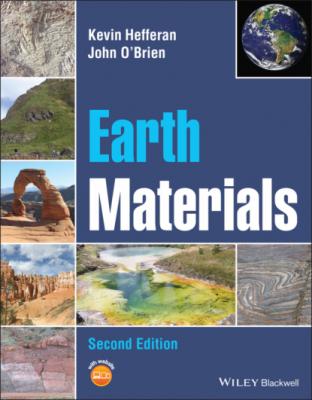Earth Materials. John O'Brien
Читать онлайн.| Название | Earth Materials |
|---|---|
| Автор произведения | John O'Brien |
| Жанр | География |
| Серия | |
| Издательство | География |
| Год выпуска | 0 |
| isbn | 9781119512219 |
Square unit meshes (Figure 4.9a) are primitive and have equal unit translation vectors at 90° angles to each other (p, ta = tb, γ = 90°). Primitive rectangular unit meshes (Figure 4.9b) differ in that, although the unit translation vectors intersect at right angles, they are of unequal lengths (p, ta ≠ tb, γ = 90°). Diamond unit meshes have equal unit translation vectors that intersect at angles other than 60°, 90° or 120°. Diamond lattices can be produced and represented by primitive diamond unit meshes (p, ta = tb, γ ≠ 60°, 90° or 120°). They can also be produced by the translation of centered rectangular unit meshes (Figure 4.9c) in which the two unit mesh sides are unequal, the angle between them is 90°, and there is a second node in the center of the mesh (c, ta ≠ tb, γ = 90°). In a centered rectangular mesh there is a total content of two nodes = two motifs. If one looks closely, one may see evidence for glide reflection in the centered rectangular mesh and/or the larger diamond lattice. The hexagonal unit mesh (Figure 4.9d) is a special form of the primitive diamond mesh because, although the unit translation vectors are equal, the angles between them are 60° and 120° (p, ta = tb, γ = 120°). Rotation through 120o generates three such unit meshes which combine to produce a larger pattern with hexagonal symmetry. Oblique unit meshes (Figure 4.9e) are primitive and are characterized by unequal unit translation vectors that intersect at angles that are not 90°, 60° or 120° (p, ta ≠ tb, γ ≠ 90°, 60° or 120°) and produce the least regular, least symmetrical two‐dimensional lattices. The arrays of nodes on planes within minerals always correspond to one of these basic patterns.
4.3.3 Plane lattice groups
When the ten plane point groups are combined with the five unit meshes in all ways that are compatible, a total of 17 plane lattice groups are recognized on the basis of the total symmetry of their plane lattices. Note that these symmetries involve translation‐free symmetry operations that include rotation and reflection, translation and compound symmetry operations such as glide reflection. Table 4.2 summarizes the 17 plane lattice groups and their symmetries. Primitive lattices are denoted by “P” and centered lattices by “C.” Axes of rotation for the entire pattern perpendicular to the plane are noted by 1, 2, 3, 4, and 6. Mirror planes perpendicular to the plane are denoted by “m”; glide planes perpendicular to the plane are denoted by “g.”
Figure 4.9 The five principal types of meshes or nets and their unit meshes (shaded gray): (a) square, (b) primitive rectangle, (c) diamond or centered rectangle, (d) hexagonal, (e) oblique.
Source: Nesse (2016). © Oxford University Press.
Table 4.2 The 17 plane lattice groups and the unique combination of point group and unit mesh that characterizes each.
| Lattice | Point group | Plane group |
|---|---|---|
| Oblique (P) | 1 | P1 |
| 2 | P2 | |
| Rectangular (P and C) | m | Pm |
| Pg | ||
| Cm | ||
| 2mm | P2mm | |
| P2mg | ||
| P2gg | ||
| C2mm | ||
| Square (P) | 4 | P4 |
| 4mm | P4mm | |
| P4gm | ||
| Hexagonal (P) (rhombohedral) | 3 | P3 |
| 3m | P3m1 | |
| P3lm | ||
| Hexagonal (P) (hexagonal) | 6 | P6 |
| 6mm | P6mm |
The details of plane lattice groups are well documented (see for example, Klein and Dutrow 2007), but are beyond the introductory material in this text.
4.4 THREE‐DIMENSIONAL MOTIFS AND LATTICES
Minerals are three‐dimensional Earth materials with three‐dimensional crystal lattices. The fundamental units of pattern in any three‐dimensional lattice are three‐dimensional motifs that can be classified according to their translation‐free symmetries. These three‐dimensional equivalents of the two‐dimensional plane point groups are called space point groups.
Space point groups can be represented by nodes. These nodes can be translated to produce three‐dimensional patterns of points called space lattices. Space lattices are the three‐dimensional equivalents of plane nets or meshes. By analogy with unit meshes or nets, we can recognize the smallest three‐dimensional units, called unit cells, which contain all the information necessary to produce the three‐dimensional space lattices. In this section, we will briefly describe the space point groups, after which we will introduce Bravais lattices, unit cells, and their relationship to the six (or seven) major crystal systems to which minerals belong.
Figure 4.10 A primitive unit cell and a long‐range space point lattice that results from its repetition by symmetry operations in three dimensions.
4.4.1 Space point groups
In minerals, the fundamental motifs are parts of clusters of three‐dimensional coordination polyhedra sufficient to establish the composition of the mineral. When these are repeated in three dimensions during mineral growth, they produce the long‐range order characteristic of crystalline substances (Figure 4.10). Like all fundamental units of pattern, these three‐dimensional motifs can be classified
